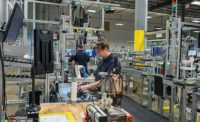If you can’t see it, you can’t measure it, and if you can’t measure it, you can’t improve it! This is the simple mantra of successful manufacturers the world over. Manufacturing excellence can only come from manufacturing visibility.
Visibility is key, and that visibility needs to be clear, precise and timely. The best manufacturers have simple, instant visibility to product, process, quality, test, and materials information factorywide. The benefits of such visibility are well known to the manufacturing community, and yet achieving it has proven elusive for many. This article identifies the primary elements of information visibility and explores the different technical approaches towards achieving it. Finally, it compares the commercial ramifications of the different approaches.
Clear, Precise and Timely
Data is at the core of every successful manufacturing process, so it is essential to start with the assumption that all the systems and operations within the factory gather and maintain information in a meaningful and timely fashion. This means connecting all the data, from inbound materials through materials management, production, test, quality control, packing, dispatch, and even into aftermarket services.
When talking about visibility, the debate is often restricted to the processes within the factory walls, but the greatest benefit is always achieved when a holistic visible supply chain approach is adopted. Indeed, applying disciplines like Six Sigma, Industry 4.0, paperless factory or lean manufacturing always works best when applied throughout the supply chain.
The basic requirement of any manufacturing operation is the ability to collect and store data centrally, but that data is useless if it does not enable improvement, corrective action and the pursuit of excellence. This can only be done if the data is properly mined and appropriately displayed to the right people at the right time. The right data, at the right time, delivered to the right people in a manner that they can act upon, is the best formula for achieving real operational excellence.
The phrase “I can’t see the forest for the trees” is often used when data is delivered to a single source, in a poorly organized format. The ability to process and act upon data starts with the ability to visualize that data in a way that can be analyzed and interpreted. This doesn’t mean delivering all the data to one person with a huge number of
performance indicators or measurements. It means delivering the data needed to do the best job. For a line operator, the data required may be minimal and may reflect simple elements, such as machine performance, uptime or shortages. Engineers might need data on the performance of a particular product in test, so they can analyze the reasons for failures. And, production planners will need to see data that allows them to better plan and consider what-if scenarios around increased volumes or supply chain disruptions.
Those with a vested interest in timely precise data span the entire organization from the shop floor to the boardroom and everyone in between. The data that helps the operator accelerate a changeover will contribute to the data that allows the COO to make the right capital equipment investment or outsourcing decisions. The visible factory is an enterprisewide strategy with enterprisewide value.
Having established the clear and undeniable value of the transparent factory, what are the critical elements required for making information visible and useful to the enterprise?
The types of data visibility required to achieve a transparent factory are related directly to the activities and roles of those who require information in their day-to-day jobs. The data needs are either real-time or historic, and these are delivered to the user in several formats, such as dashboards, analytics, reports and, most recently, mobile applications for those needing access to data on the move.
Real-time information is most commonly delivered in what we currently call dashboards. A process engineer or a line manager will often use this kind of data presentation to maintain and improve the performance of the line. The data has to be instantaneous. Any delay is likely to cause or extend downtime, with the subsequent impact further along the line. This kind of data delay can also cause quality challenges and reduced yield, as the overhang of faulty assemblies increases while an error is detected and corrective action taken. This data is best delivered in a simple graphical manner with strong visual and even audio alerts delivered when a potential problem is likely to occur. The need for instant data here is obvious: The faster the alert, the faster the reaction and the eventual solution.
Historical data is needed for production control, engineering, quality and test. It’s also needed for management to monitor, analyze and adjust production based on current and predicted status. This is where traceability enters the equation. Traceability, like visibility, is an essential cornerstone of any manufacturing excellence program that seeks to add value, reduce costs and mitigate risk. The word “history” here is used to define anything that has happened, and not ancient history. If it’s not real-time, it’s historic.
The delivery method and presentation style for historical data can take many forms. Reports and detailed analytics are the basics of any transparent system, and the details included are essential in informing many decisions about product selection, business and market planning, as well as the full gamut of supply chain decisions, such as vendor selection, logistics programming and fulfilment solutions.
Most recently, viewing methods have become a critical factor when data is being used by an organization. Mobility is the norm in modern business, and the team’s ability to stay connected to the data via mobile analytics has become critical. The use of smartphones and tablets has skyrocketed, and more and more workers are using their own devices in a work environment. This means any system absolutely must be visible through smartphone and tablet-based applications.
Selecting and Presenting Data
Knowledge is power, and the power to select the information needed and how that information is delivered should be put in the hands of those using the data. It would be easy to let the IT department design and deliver various dashboards to those who need them, assessing requirements, driving metrics and providing a one-size-fits-many solution. This is firstly a burdensome task for any IT team, all of whom are at least stretched, and in most cases overworked.
But perhaps more importantly, it does not deliver the kind of tailored information that each individual might want to see to allow them to better discharge their responsibilities. Putting the layout of the dashboard into the hands of the people who will derive use from it is the only way to empower them, ensuring they have exactly what they want, when and where they need it. The more practical, and most successful, solutions occur when the power to design the dashboard is delivered to the user. The least attractive and agile solution occurs when the users relinquish responsibility for data configuration and assign it to the integrator or vendor.
Flexibility is also essential at the initial stage. Dashboards and configurations should be allowed to develop and evolve. The data needed by an individual today may not be the same as that required tomorrow. What’s more, not everyone will get their dashboard specification right the first time. They will want to adapt as they go and as they see what data points assist them the most. They may drop less relevant material, just as they may find data they didn’t expect to need essential.
Configurable dashboards are an essential feature of a successful system and are at the heart of the transparent factory. Configuring dashboards needs to be as simple as dragging and dropping elements into a design space, telling each element where to derive its data and exactly how to display it. This needs to happen without input from the IT team and certainly without any coding, structured query language (SQL) or IT knowledge. Without this simplicity and flexibility, the system will not keep pace with the enterprise’s or the teams’ requirements for differing and changing data presentation.
Not all dashboards need to be truly real-time. Some will only need to be refreshed once an hour, once a day, or even once a week. Factories typically display their monthly quality and production charts on a wall or a notice board on the factory floor, usually printed out and pinned up. A transparent factory will likely have screens at these locations with the data displayed on dashboards updating on a regular basis with longer-term analytics rather than real-time information included. This is essentially a hybrid between a live dashboard and a report, providing information that is refreshed at a predetermined rate.
Reports and analytics should have the same flexibility, being entirely and simply configured by a user with no coding, SQL or IT skills. Otherwise, every new report or minor change to an existing report will be expensive and will create delay. A reporting system that enables data mining via a graphical interface and data interrogation by visually traversing the graphs and data sets is the only means to meet the ever-changing analytics demands of a truly transparent factory. Of course, the ability to write SQL if needed should be present, but it cannot be the only means of generating reports. These flexible reports are hugely valuable when teams meet to resolve a specific issue, and the transparency means they can mine deeper into specific data when required.
In addition to reports that are generated on demand, the system should have the ability to provide automated scheduled reports. Many employees who need or are able to make use of data do not have the time or the inclination to go into a system and generate a report. Systems should automatically generate reports on a regular basis and distribute those reports to the parties who will obtain value from them. These auto-generated reports might be for a single shift, day, week or even month, highlighting key data as well as trends that allow better decisions to be made. Some users might benefit from the reported data even if they play an entirely passive role in the ecosystem.
Again, this user configuration and flexibility must apply regardless of the display device. Most important, the same data and same customizable nature should apply to mobile devices. Being able to build a dashboard for the smartphone or tablet as well as the desktop or shop-floor display is essential to allow on-the-move users to access the data they need, particularly when emergency analysis and reaction is required.
In addition to accommodating a mobile workforce, it is also important to consider a data ecosystem that operates beyond a single facility and a single geography. With businesses and supply chains operating on an increasingly global basis, reporting tools must have the means for groups of staff to interrogate and traverse large data sets across multiple facilities in multiple geographies. The data may even need to be shared with multiple vendors when a partially or fully outsourced model is deployed.
Collaborative data mining can be valuable in a team meeting where the root cause of problem is not fully understood. Flat static reports are rarely conclusive in themselves, and the ability to drill into data in real-time can quickly reveal causes and inevitably lead to solutions.
Two Solutions, Two Outcomes
When it comes to resolving all the issues that the transparent factory generates, there are two polarized approaches. One solution is customization, and the other is empowerment.
The customization model may appeal at first, offering multiple solutions that deliver a unique dashboard or report for every perceived eventuality. However, it will clearly be the most rigid in the long term. It will also require the most interaction with IT, the integrator and the vendor.
A better approach is to empower factory personnel to create their own data outputs and dashboards. First, it does not require a detailed plan that needs to be applied without deviation. That in itself takes time and resources to research and build. Such a plan can only reflect the demands of that moment, regardless of how detailed and complete it is. Second, by empowering users to configure the system, buy-in from the operator is obtained. They each have their own version of the system, on their own platform and they are invested in its successful deployment. Third, the system is as dynamic as your business is, changing when business or customer demand dictates.
The latter, more empowered, approach doesn’t make great demands on the IT team and does not expect coding or SQL skills from the user.
It is not reasonable to consider both options without weighing the costs of deployment. A custom solution may initially seem to offer the best value, but it is without doubt a path to endless costs of additional customization and updates. This may mean the loss of time and agility to the business way beyond the basic cost of programing time.
The empowered solution delivers user-customizable dashboards and reports as well as intuitive data mining. It offers a system that is as flexible and agile as any enterprise and reacts to changes in the same way a successful enterprise does.
Transparency, traceability, visibility, agility and the ability to mine data and deliver it in a way that allows for the prompt response to every issue will set successful enterprises apart as we continue to move into a world where rapid change is the norm.
A fully transparent approach can have an impact on the business that goes well beyond the cost of the initial implementation. More empowered staff are likely to be more proactive in resolving challenges within the business and from the customer. They are also likely to be proactive and enabled in improving the processes they work on, potentially increasing yield, reducing scrap or waste, and lowering costs.
Visibility and transparency mean the world to customers. The ability to retain and grow customer business can be directly associated with their perception of a vendor as open, honest, agile and responsive to their needs.
For more information, call Aegis Software at 215-773-3571 or visit www.aiscorp.com.










